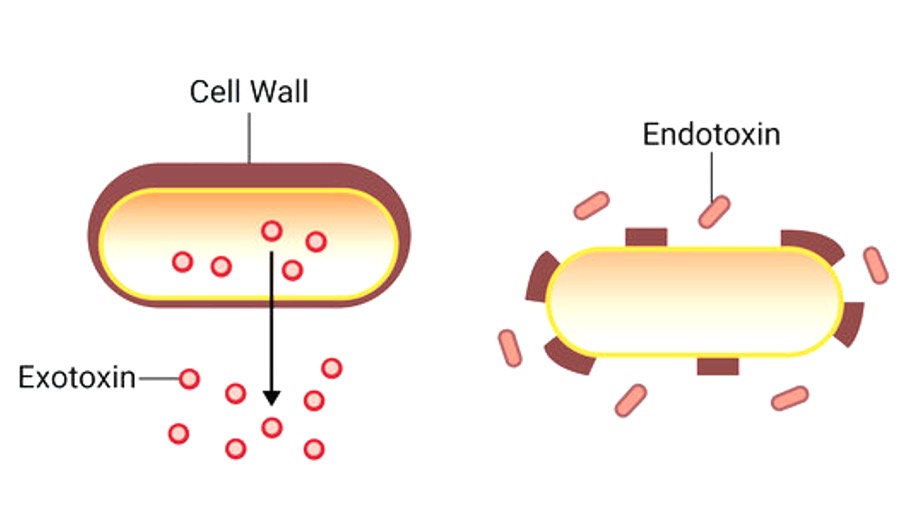Differences Between Exotoxins Vs Endotoxins
Toxins are small chemicals, peptides, or proteins created by living cells that, when they come into contact with or are ingested by tissues, can result in morphological changes or structural damage. Enzymes and toxins both contribute significantly to the pathogenicity of pathogenic bacteria. Toxins can promote invasiveness, harm cells, impair biological functions, or provoke an immune reaction and cell damage.

Toxins are of two types: Exotoxins Vs Endotoxins
| S.N. | Character | Exotoxins | Endotoxins |
| 1. | Definition | Proteins are produced inside pathogenic bacteria as a part of their growth and metabolism. | Lipid portions of lipopolysaccharides (LPSs) are part of the outer membrane of bacteria. |
| 2. | Produced by | Mostly Gram-positive bacteria and some Gram-negative bacteria. | Gram-negative bacteria. |
| 3. | Chemical Nature | Protein (polypeptide) complexes | Lipopolysaccharide-protein complexes |
| 4. | Molecular weight | 10KDa. | 50-1000KDa. |
| 5. | Components | Usually composed of two subunits, A and B. | Composed of three basic components: |
| The A subunit is seen to have catalytic activity, whereas the B subunit is required for binding with an appropriate cell receptor. | 1. O-antigen | ||
| 2. Core oligosaccharide | |||
| 3. Lipid A | |||
| 6. | Enzymes present | Hyaluronidase, Collagenase, certain protease, Nuclease, Neuraminidase, Certain protease, Phospholipase A | Catalase, Fibrolysin, IgA / IgG proteases |
| 7. | Chromosomal Location | Located on extrachromosomal genes (e.g., plasmids). | Located on chromosomal genes. |
| 8. | Secreted by | Secreted by organisms; living cell | An integral part of the cell wall; lysed cell |
| 9. | Secretion | Secreted out of the cell. | Generally not released outside the cell until the death of a cell. |
| 10. | Cell Lysis | Not required | Required |
| 11. | Stability to heat | Heat labile (60-80°C) | Heat stable (250°C) |
| 12. | Filtration | Filterable | Not Filterable |
| 13. | Boiling | Denatured on boiling | Not denatured on boiling. |
| 14. | Enzyme Activity | Mostly has enzymatic activity. | Enzymatic activity absent or limited. |
| 15. | Specificity | Exotoxins are enzymes; this makes them highly specific in their mechanism and for their host cells. | Endotoxins are comparatively not very specific in nature. |
| 16. | Specific receptors | Usually binds to specific receptors. | Specific receptors not found. |
| 17. | Specificity to a bacterial strain | Specific to certain bacterial strains. | Not specific to any bacterial strain. |
| 18. | Immunogenicity | Highly immunogenic. | Weakly immunogenic. |
| 19. | Fever Induction | No | Fever by induction of interleukin 1 (IL-1) production. |
| 20. | Toxicity | Highly toxic, fatal in µg quantities. | Moderately toxic, fatal in mg quantities. |
| 21. | Mode of action | Various modes (Mostly by enzyme-like mechanisms). | Includes TNF and Interlukin-1 |
| 22. | Potency | High: A single toxin molecule can act on a large number of host cells. | Low: A large amount of toxin is needed to cause disease. |
| 23. | Effects | Either cytotoxin, enterotoxin, or neurotoxin with defined action on cells or tissues. | General symptoms such as fever, diarrhea, vomiting, etc. |
| 24. | Neutralization by Antibodies | It can be neutralized. | It cannot be neutralized. |
| 25. | Detection | Detected by many tests (neutralization, precipitation, etc.) | Detected by Limulus lysate assay. |
| 26. | Conversion to Toxoids | Possible (On treatment with formalin). eg. For the prevention of diphtheria, botulism, and tetanus. | Not possible |
| 27. | Availability of vaccines | Effective vaccines are available. | No effective vaccines are available. |
| 28. | Diseases caused | Tetanus, diphtheria, botulism, etc. | Meningococcemia, sepsis by gram-negative rods, etc. |
| 29. | Examples | Toxins produced by Staphylococcus aureus, Bacillus cereus, Streptococcus pyogenes, Bacillus anthracis | Toxins produced by E.coli, Salmonella Typhi, Shigella, and Vibrio cholera |
References
- Difference Between Endotoxins And Exotoxins
- Difference Between Endotoxins And Exotoxins





